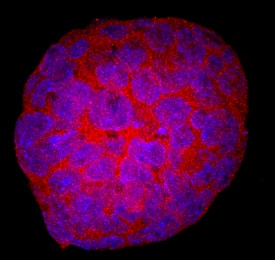Mouse EphA1 Antibody
R&D Systems, part of Bio-Techne | Catalog # MAB30341

Key Product Details
Species Reactivity
Applications
Label
Antibody Source
Product Specifications
Immunogen
Glu27-Glu548
Accession # AAH71215
Specificity
Clonality
Host
Isotype
Scientific Data Images for Mouse EphA1 Antibody
EphA1 in D3 Mouse Cell Line.
EphA1 was detected in immersion fixed D3 mouse embryonic stem cell line using Rat Anti-Mouse EphA1 Monoclonal Antibody (Catalog # MAB30341) at 10 µg/mL for 3 hours at room temperature. Cells were stained using the NorthernLights™ 557-conjugated Anti-Rat IgG Secondary Antibody (red; Catalog # NL013) and counterstained with DAPI (blue). Specific staining was localized to cytoplasm and cell secretion. View our protocol for Fluorescent ICC Staining of Stem Cells on Coverslips.Applications for Mouse EphA1 Antibody
Immunocytochemistry
Sample: Immersion fixed D3 mouse embryonic stem cell line
Formulation, Preparation, and Storage
Purification
Reconstitution
Formulation
Shipping
Stability & Storage
- 12 months from date of receipt, -20 to -70 °C as supplied.
- 1 month, 2 to 8 °C under sterile conditions after reconstitution.
- 6 months, -20 to -70 °C under sterile conditions after reconstitution.
Background: EphA1
EphA1, also known as Eph and Esk, is a member of the Eph receptor tyrosine kinase family and binds several Ephrin-A ligands. The A and B class Eph proteins share a common structural organization (1-4). The mouse EphA1 cDNA encodes a 977 amino acid (aa) precursor that includes a 24 aa signal sequence, a 524 aa extracellular domain (ECD), a 21 aa transmembrane segment, and a 408 aa cytoplasmic domain. The ECD contains an N-terminal globular domain, a cysteine-rich domain, and two fibronectin type III domains. The cytoplasmic domain contains a juxtamembrane motif with two tyrosine residues which are the major autophosphorylation sites, a kinase domain, and a conserved sterile alpha motif (SAM) (5, 6). Within the ECD, mouse EphA1 shares 84% aa sequence identity with human EphA1, approximately 40% aa sequence identity with mouse EphA2, 3, 4, 6, 7, and 8, and 27% aa sequence identity with mouse EphA5. A splice variant of mouse EphA1 lacks the transmembrane segment and is predicted to exist as a soluble molecule (7). Membrane bound or clustered Ephrin ligands interact with EphA1 and activate its kinase domain which is capable of Ser, Thr, and Tyr phosphorylation (7). Reverse signaling is propagated through the Ephrin ligand. EphA1 is widely expressed in differentiated epithelial cells, particularly in bone marrow, spleen, thymus, and testes (5, 7). It is expressed on CD4+ T cells but not on CD19+ B cells (8). On T cells, EphA1 induces Tyr phosphorylation of PYK2 and promotes chemokine-induced chemotaxis (8). EphA1 is upregulated or downregulated in a variety of human carcinomas and is implicated in tumor invasiveness (2, 9, 10).
References
- Poliakov, A. et al. (2004) Dev. Cell 7:465.
- Surawska, H. et al. (2004) Cytokine Growth Factor Rev. 15:419.
- Pasquale, E.B. (2005) Nat. Rev. Mol. Cell Biol. 6:462.
- Davy, A. and P. Soriano (2005) Dev. Dyn. 232:1.
- Coulthard, M.G. et al. (2001) Growth Factors 18:303.
- Lickliter, J.D. et al. (1996) Proc. Natl. Acad. Sci. USA 93:145.
- Douville, E.M.J. et al. (1992) Mol. Cell. Biol. 12:2681.
- Aasheim, H-C. et al. (2005) Blood 105:2869.
- Iwase, T. et al. (1993) Biochim. Biophys. Res. Commun. 194:698.
- Hirai, H. et al. (1987) Science 238:1717.
Alternate Names
Gene Symbol
UniProt
Additional EphA1 Products
Product Documents for Mouse EphA1 Antibody
Product Specific Notices for Mouse EphA1 Antibody
For research use only
